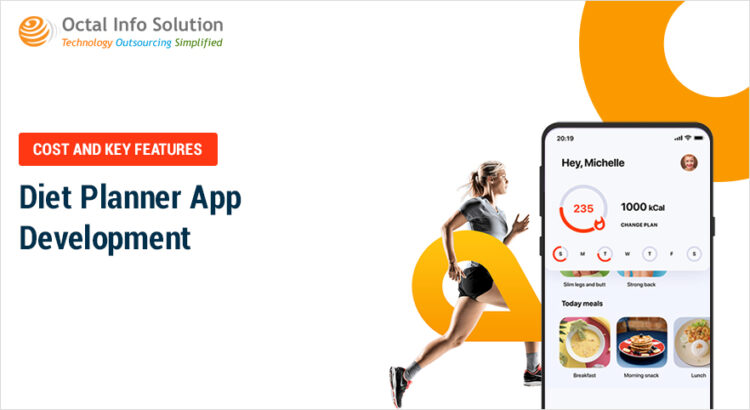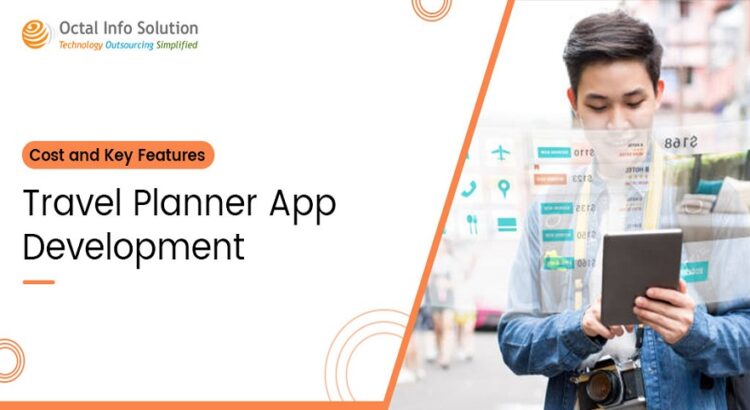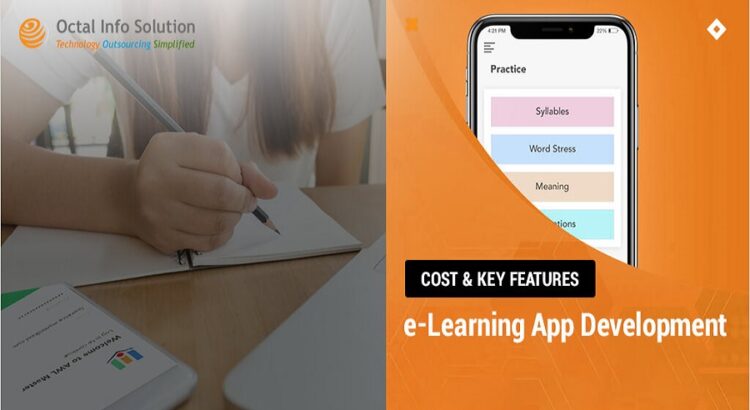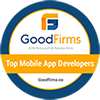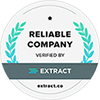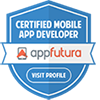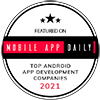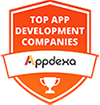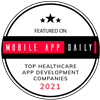Over the past few years, the demand for a healthy diet and food has taken a high leap as people are more health-conscious. People are more inclined to a nutritional diet and staying healthy is their top priority. Due to such an extreme demand for diet and nutrition, many giant businesses want to dive into the mHealth market and attain their best position in the diet app.
In this article, we are talking about the diet planner application development, current industry stats, business models it is aligned with, types of diet planner apps, features, and development cost. We will give you the answer to why a diet and nutrition app is worth having. So, keep reading this blog, stay tuned with us.
What is a Diet and Nutrition Tracking App?
Diet planner app is a must-have for the users in their smartphones, to keep themselves healthy and fit. These apps help you to identify the amount of nutrition content your body would require. Have you faced a struggle in quality sleeping, or you have not known the effective measures to lose weight, or you want to determine the calorie count? This app helps you everywhere to achieve your goals and keep you motivated. With the presence of advanced technologies like AI chatbots are your assistant and are supportive to reach your dream of being healthy and fit. Plenty of apps like Rise, Lose it, Eat this much, etc. with different niches, are in the market to support you throughout your journey.
Target Audience
The normal target audience using the diet planner app is the youth. Among the people of the age of 30-45 years, 17% are utilizing these apps to achieve their daily goals. Around 26% of people between the age of 18 to 29 years are prone to regularly use apps for counting their energy levels and healthy diet plan.
Market & Growth Stats
The current market size of diet and nutrition apps in the market lies at $3.9B, and the group of researchers has concluded that this revenue is forecast to be $15.5B by the year 2028 with a growth rate of 21.6% CAGR.
With the increase in the continuous demand for the health and nutrition assessment, fitness trackers, and exercise and weight loss segments, from multiple industries, the market size of diet and health-related mobile applications are in high demand. After the arrival of COVID-19, these apps motivate huge awareness among people for their health and fitness. People are more prone to use smartphones in their daily lives and hence, they are always looking for investing in health and nutrition alternatives and home fitness equipment (Apple Watch, Fitbit). As per the survey, the market of smartphones has penetrated with a rate of 65% to reach $6B by 2025.
The diet and nutrition apps are fused with advanced generation technologies like AI & ML, and IOT, to deliver great personalized options to their customers. Assembled features like customized diet charts, tracking heartbeat & footsteps, workout routines, easy-to-go food recipes, one-to-one live health coaches, and social sharing options are the in-demand parameters for these mobile apps.
One of the greatest players in 2020 in the diet and nutrition app industry is MyFitnessPal (MFP) Inc., with revenue of $6.7M, which helps its users to confer personalized diet and activity tracking. Some of the other industry key players in the Diet and Nutrition App market are Fitbit, Adidas, Azumio, Appster, Nike, and many more.
Business Models
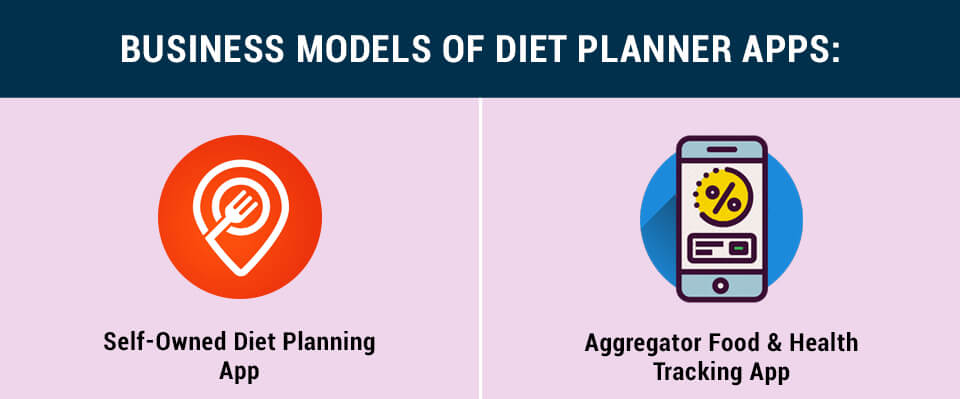
1. Self-Owned Diet Planning App:
This type of business model is used by the single person/owner to keep an eye over his business and is limited to single brands products or services.
2. Aggregator Food & Health Tracking App:
As the name suggests, the aggregator app for food and health, allots a mix of brands over a single channel and earns a commission from them, and facilitates with their services to hold different owners. There are a broad variety of niches complementing one another inside the same panel, like nutritionists, dieticians, and fitness centers.
Monetization Opportunities
After you have launched your application amongst the audiences, your next call would be to gain high revenue and profit with it. Companies that do not correspond with their mobile apps will end up in the loss of business. There are different revenue models to consider and adopt the one which is most appropriate for your business. Let below understand different monetization models for diet plan app development.
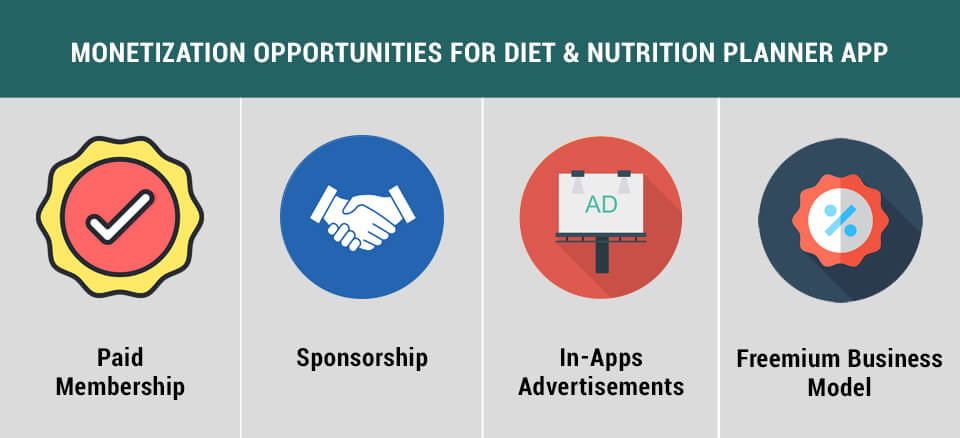
1. Paid Membership:
People used to pay a fee for downloading mobile apps which have paid membership. To reply to this method, make sure your app is highly efficient and responsive, and up to the mark to beat the heat of freely downloadable apps. My Diet Coach is one such app, providing paid services to the people inside their mobile app. They have attached more advanced features like a calorie calculator, barcode scanner, in-app graphs, and rewards for their users.
2. Sponsorship:
This type of revenue generation model is used to allow sponsors who want to support nutrition and diet-based applications. Businesses have their reasons to get connected with new audiences, increase their level of business.
3. In-apps advertisements:
It is the ultimate monetization model for people’s attention, and generates revenues. But try to keep those ads in their relevant position to restrict the waste of money for these ads. You can place these multiple modes of ads like banner ads, video ads, native ads, etc. Fooducate uses such a method.
4. Freemium Business Model:
As the name suggests, this model obtains free apps to cover a large sum of people. This method is one the best methods to gain the attraction of large users, as it is free. Although, you can attach few paid options in the app to give more advanced features to your users. MyFitnessPal and Fooducate use this model with the paid version to give more value-oriented features for users like nutrition dashboard, carb and protein tracking, food library, gluten-free diets, and many more.
Market Leaders in Diet Planner Apps:
Let’s list out the market leaders in the nutrition and diet app industry to keenly examine their productivity and revenue models. Yet some of the models offer only one function, while some have offered a set of functionalities.
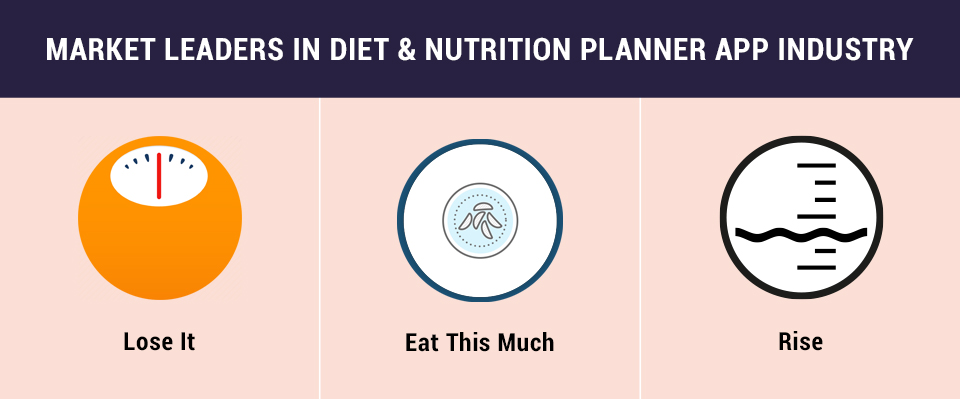
1. Lose It:
This one is the top calorie tracker app, next to MyFitnessPal with a user penetration of 27M. It has featured in many of the top magazines feeds like The Wall Street Journal and CNN. Many features they have composed inside the app like daily calorie tracking, nutrition tracker (protein, sugar, and carb), meal planning, and workouts. Users can switch to their wearables like GoogleFit.
2. Eat This Much:
This one is the calorie plan app, which allows creating personalized meal plans for users based on their food preferences, budget, and schedule for monthly and weekly customized goals.
3. Rise:
This one is the sleep tracking application, preferred by customers to enjoy a sound sleep. Rise helps you to increase your level of peaceful sleep and gain the maximum strength for your body. Features like sleep debt and circadian rhythm allow you to unlock better sleep and more energy.
General Features/Panels
For Users:
Registration: From this section, users can register by entering personal information such as their name, gender, age, weight & height.
Set Targets: This is the section, where weekly targets are set by the users to track their calorie counts and to verify the data with the last calorie intake.
Food Logs & Nutrition Value: In this, users can find daily calorie counts, and keep track of meals and food consumed.
Book your appointment: Users get to set & book appointments with their nutritionist to change or upgrade diet charts, according to their fitness sessions.
Receive Notifications: Users receive notifications regarding the daily fitness goals & meals which they need at a particular time zone.
Linking to Live Experts: According to the dietary needs of users, they can have a communication with their nutritionists, sharing their views regarding present meal plans and get them modified, in case needed.
For Admin:
Sign-up/Log-in: Same as the user panel, in this section, the admin can log in with the aid of their email ID or social networking account credentials.
User Manager: Here the Admin monitors and manages the users that are associated with the diet planner mobile app.
Check Bookings: From this section, the admin will be able to track the number of bookings received as well as the ones that are completed or pending.
Statistics regarding various activities: In this section, all-important charts & figures regarding activities like the number of user bookings for a new diet chart, previous plans & formal discussions that took place with the users are monitored & verified.
Email/Chat Support: Here in this section, the admin gets to communicate with users, and suggest necessary changes in diet charts for confirmation meetings.
Subscription packages: Over here, Admin manages all packages subscribed on a monthly/ quarterly/yearly basis. The Admin will also be able to track the most availed subscription offers.
Loyalty Programs: This section allows Admin to track the rewards & loyalty programs introduced on his/her purchase as well as the offers & services attuned to it.
Content Management System: From here the Admin manages the app-related content as well as the one that runs on banners, ads & social networking sites.
Advanced Features of Diet Planner App Development:
Real-time Analytics:
This feature allows the admin to take immediate decisions for streamlining the business functionalities. The data for user orders, type of requests, the category of users who visit the most, and other crucial data can also be easily analyzed to make effective business decisions.
Payment gateway integration:
Your diet planner apps can be all the more successful upon incorporating digital payment options, like e-Wallet, Credit/Debit card payment, Netbanking, etc. Using various payment modes, users can easily select any service and avail themselves whenever needed.
Push Notifications:
It is an amazing technology to engage users. It not just keeps them attentive & attuned to special deals/offers/news/events/fitness objectives and a lot more, but also assures that your mobile app stays on their Smartphone for a long time. Integrating this feature not just makes your mobile app visible but is also helpful in user acquisition & retention.
Wearable Device Integration:
It is a crucial feature to have in this kind of mobile app, as to check the calories intake, you won’t have to open the mobile app each time. A smooth connection between the diet planner app and wearable devices, prompts users to download your mobile app. This feature allows the users to check their calorie counts instantly on their wrists and accordingly plan their other meals. Hence, this feature greatly contributes to your mobile app.
Custom Meal Reminder System:
Everyone is going to enjoy getting reminders related to their diet charts & calorie intake. After all, each one of us desires to stay fit. Hence, these reminders fit best for people who run a tight schedule as this way they can be kept informed regarding the meals to be consumed.
Not just this, but this feature also notifies them to plan the right calorie intake & burnt ratio. Hence, it not just keeps your users engaged but also leaves them free from the task of monitoring their health now and then.
Personalized Tips & Tricks:
As per the user’s current physical location & dieting goals, these apps send them tips & tricks to lead a healthy life. These personalized tricks & techniques are a great way to keep the users engaged as well as keep them motivated to improvise their health.
Analyze My Health:
It is an amazing feature of a Diet Planner mobile app. Body temperature, heart & pulse rate, blood pressure, and other things are stored to track user sweat information. Hence, users can easily monitor their fitness activities as well as it enables them to go for an optimized diet chart, which perfectly aligns with their health-related requirements.
Blog:
It is a tech-savvy world we live in, where we keep coming across some brilliant ideas & news as we surf the internet. Hence, Blogging can truly benefit your mobile app and make it all the more appealing. Users & Admin can share trending health ideas, healthy recipes & other things, thus keeping associated users updated regarding the latest fitness trends.
Required Team Structure for Diet Planner App Development:
While developing an integrated and advanced technologies mobile app like the Diet Plan app, requires a well-flourished team of experts to weave every corner of designing and development inside the project.
Project Manager: Manage all of the mobile application projects, coordinate with the rest of the team members to ensure the correct projection of the project. Must have prepared a well-curated document of every brief and solution to achieve the aim.
Developers: Consists of two kinds of developers offer say front-end and back-end developers. Front-end developers are developing the front-side coding part using the languages HTML, JavaScript, React Native, etc., whereas back-end-side developers handle the databases and security using the languages Python, MongoDB, etc. Based on the platform either Android or iOS, developers distributed the technologies. For the iOS platform, Swift and Objective-C are the main languages developers used to work on.
Designers: UI/UX designers are there, with Graphic designers.
Testers: Quality Testers are there to ensure smooth testing of every section of code and design. They help to check the error.
Technology Stack for Diet Planner App Development:
To develop a feature-rich diet planner mobile app you need a robust & brilliant framework. Hence, before proceeding with the development framework make sure that you have the required set of technologies, such as:
User Interface & Experience (UX/UI): CSS3 & Bootstrap can be chosen by app developers for the front end, whereas JavaScript, AngularJS, Django, Python, Ruby works best for Backend. Meanwhile, for the Android version, Java is apt and Swift for iOS.
Nutrition Feeds: NutritionX, MyFitnesspal
Location Tracking: As per users’ proximity sensors, it is easy to determine their exact location. Apple Maps & Google Maps are apt location tracking tools for iOS & Android, respectively.
Cloud: To securely store the app, developers can use Amazon data servers or Google cloud storage.
Real-time Analytics: To track the number of users who visit the website, the number of downloads, the Bounce rate, and other related information, Google Analytics can be used.
SMS, Voice & Phone Verification: To marinate a transparent ecosystem Facebook SDK or Google sign-in used by App developers between the communication.
Database: To store consumer leads in an organized manner in the database, the app developer can go with MySQL, Mongo, Postgres, HBase, Cassandra, etc.
Cost of Diet Planner App Development:
The mobile app development firms and dedicated mobile app developers charge on a per-hour basis for mobile app development. In countries like the USA or Europe, the prices are starting from $200 to $550. The prices in Eastern Europe are lower compared to other parts of the Europe region, starting from $200 to $600 per hour. In India, the development cost of a Diet Planner app starts from a low rate of $25 to $200 per hour.
Thus, when the entire meal planning app development cost is calculated the average price for a single platform (either Android or iOS) is going around $10,000 to $25,000. Then again, if you choose to develop a fully-featured and polished mobile app, the cost will escalate up to $40,000.
Conclusion:
It’s undoubtedly true that diet and nutrition apps are rigorously growing in demand and offers a large pool for both new and old businesses in 2021. All you need to do is identify your niche and reach out to a mobile app development company that can help you to sort everything from scratch and make it fully functional. Ample companies are offering you their services, don’t get confused with them. You can connect with us to resolve any issues. We are the ones who can convey your generosity into the product to a large number of people and make a big change in their lives to achieve a healthy body and diet plan.


